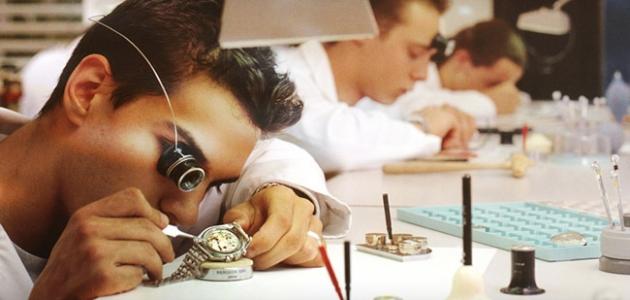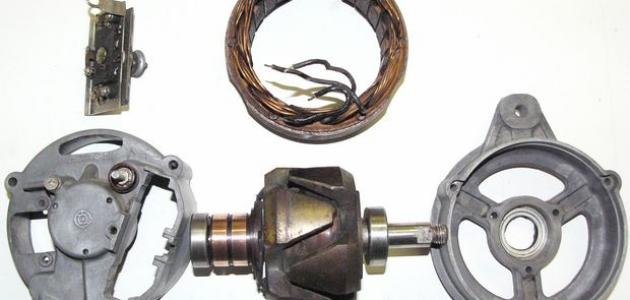History of watchmaking
Humans have been interested in knowing the time of day since ancient times. They used the direction of the shadows made by the sun's rays when they fall on vertical or inclined columns on the surface of the Earth. This method determines the time in an approximate and inaccurate manner. Therefore, humans invented sand and water clocks that work by flowing water or sand between two containers, and the time is known in them by determining the height of the surface of the water or sand remaining in the container at a given moment, and with the increased interest in knowing the time more accurately, mechanical clocks appeared in 829 AD, but These watches did not reach the degree of accuracy that could be relied upon in determining time.
With the passage of time, the watch industry began to develop significantly, as pendulum watches were manufactured, and watches containing hair springs that have the property of stabilizing the duration of the oscillation, and the development of the watch industry has continued until the present time. Despite the great progress in watchmaking, it has not achieved precise timekeeping at all. Due to the influence of pressure and temperature factors on the length of the pendulum or spring, which leads to a change in the duration of its oscillation by which time is measured, it has been shown that the only clock that cannot make a mistake in measuring time is the Earth. The time during which one revolution revolves around itself is absolutely constant.
watch industry
The method of making watches varies according to their types, and the following is information about the manufacture of different types of watches:
Read also:Pros and cons of television- Sundial: It is believed that the Chinese were the ones who invented this clock, and it appeared in the Pharaonic civilization and the Greek civilization took it from them and was used as a sundial. The sundial consists mainly of a stick or a vertical pole planted in the ground, and the time is determined by knowing the length of the shadow falling on the vertical or horizontal plane of the ground, but in The truth is, the sundial cannot be used at night and when there is no sunlight, and the time it measures is not the same on all days. Because the length of days varies according to the seasons.
- Water clock: Due to the ineffectiveness of the sundial in the absence of sunlight, the ancient Egyptians and Greeks invented the water clock that works at night and during the day and in the absence of sunlight. This clock consists of a vessel completely containing water, and a small hole in its base that allows water to seep through it, and the time is determined when The amount of water in the pot has run out. In fact, the water clock was not accurate in telling time; Because the pressure of the liquid in the container varies depending on the water level in the container, and the water may freeze when temperatures drop.
- Hourglass or glass hour: It is a machine that works by emptying sand from one bottle to another in a period of time of one hour, so it was called a clock, and it was invented by the Egyptians.
- Pendulum clock: It is a wooden clock that is hung on the wall and is characterized by its heavy weight. It mainly contains a short pendulum that represents a reliable measure of time, so that the length of the pendulum is relied upon to measure the entire period of time. The first pendulum clock was made by the Dutch astronomer and physicist Christiaan Huygens in 1656 AD. He contributed to the practical application of making pendulum clocks and considering them as a time monitor, benefiting from Galileo’s observations in 1581 AD about the timekeeping feature of the pendulum.
- Handwatch: The first small portable clock was made in the sixteenth century by a German locksmith named Peter Henlen. This clock was known as the Nuremberg Egg, as it was round in shape. After more than ten years of research and study, Heinlein was able to invent a small spring called the mainspring, which provides the watch with the energy needed to run it. The manufacture of this type of watch became famous in Switzerland, England, and France, and then these watches were developed by adding a hand that indicates the minutes. They were also able later to add a hand to indicate the seconds, and with the passage of time, the need arose to make a watch suitable for women. Therefore, a small watch was invented to be wrapped on the wrist, known as the wristwatch. In wars, soldiers found that they needed a wristwatch instead of the one they put in their pockets to make it easier for them to know the time. The wristwatch then became worn by men and women.
- The watch was developed to become more accurate and effective. Electronic wristwatches were manufactured that contained a small battery that supplied them with energy. More accurate electronic watches, known as quartz watches, also appeared.
The most famous watches around the world
Due to the importance of knowing the time and for tourism purposes, giant clocks were constructed that represent a masterpiece, and among these clocks are:
Read also:How to make perfume- The famous Big Ben clock: It is one of the greatest tourist attractions in London. It was built on a giant tower in the nineteenth century, and it was named after the one who supervised the construction of the clock tower. British Minister of Works Sir Benjamin Hall, whose nickname is Big Ben. It means the eldest son, so the name of this watch was an abbreviation of his name. A giant bell weighing approximately 16 tons was designed for the watch, which emits a loud sound that can be easily heard when a certain time has passed. In the late twentieth century, the famous clock suffered a technical malfunction. Due to the fall of a number of iron bars on it, but it was quickly repaired and returned to work again, and after a period of time this clock almost broke down again, and the reason this time was the fall of one of the clock’s drums due to the corrosion of the metal that carries it, and this caused the clock to stop working for 22 hours. One day, but the bells remained inactive for 9 months.
- Hour of the Holy Mosque in Mecca: It is the largest clock ever built in the world. This clock is located in Mecca, and directly overlooks the courtyards of the Holy Mosque in Mecca. It was built by order of King Abdullah bin Abdulaziz in 2010 AD, and its height is 400 meters above ground level, while the diameter of its facade is 40 meters, as It can be seen from a distance of more than eight kilometers.









